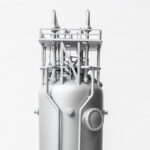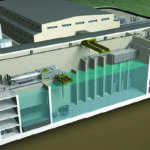NuScale has signed a first task order and a statement of commencement with Polish mining and processing firm KGHM Polska Miedź S.A., kicking off early work for a VOYGR nuclear power plant of up to 924 MWe that the partners could deploy as early as 2029 to support KGHM’s copper and silver production in Poland.
The significant agreements follow an “early works agreement” (EWA) the two companies signed on Feb. 14, setting up for project preparation, including site selection and licensing. Under the task order, NuScale will support KGHM’s application to the National Atomic Energy Agency (NAEA), which is Poland’s first for a small modular reactor (SMR). NuScale said the task order will also help further an evaluation of the NuScale Power module “through activities including drafting additional Preliminary Safety Analysis Reports and coordinating with the NAEA.” In addition, the task order also “sets the stage for the subsequent tasks in the EWA as proposed by NuScale to KGHM,” the company said.
As POWER has reported, the deal adds another major prospect to NuScale’s development pipeline of SMRs in Central and Eastern Europe, regions that have quickly emerged as a hotspot for advanced nuclear projects owing to a combination of factors, mainly related to energy security concerns prompted by Russia’s aggression in Ukraine. But it is also especially notable because it represents a deal with a large user of industrial energy, a key decentralized power market that could benefit from smaller installations of baseload, flexible power. KGHM is the second-largest industrial energy consumer in Poland. (See POWER‘s in-depth analysis on Poland’s SMR and other nuclear prospects here: “Poland Secures NuScale SMR as Urgency for Nuclear Energy Ramps Up Across Central, Eastern Europe.“)
A Nuclear Newcomer, Poland Is Working With Urgency on First Nuclear Plant
Poland has in recent months ramped up efforts to establish a nuclear power industry to accelerate the country’s energy transition. The Eastern European country holds the largest reserves of coal in Europe. But while it produced 70% of its power from coal in 2020, it unveiled a commitment last November to phase out its coal plants, targeting a 2040 timeframe—a decade earlier than the 2049 date it set earlier in 2021. The country has been steadily increasing its gas and renewable generation shares to meet stringent European Union (EU) climate goals to reach climate neutrality by 2050. Anticipating that nuclear will play a substantial for its future energy security, the country is also eyeing a 2033 target for the commercial operation of its first nuclear plant. Warsaw is actively seeking a partner to build 6 GW to 9 GW of installed nuclear capacity based on proven, large-scale, pressurized water Gen III and III+ nuclear reactor designs.
International nuclear technology vendors have scrambled for a share of this burgeoning market. While France’s EDF in October 2021 offered to build six 1.7-GW EPR units, Korea Hydro & Nuclear Power in April 2022 offered to build six 1.3-GW APR1400 units, along with a prospect to finance 20% to 30% of the project. Poland, notably, has already also signed an intergovernmental agreement with the U.S. to explore as much as 9 GW of installed nuclear capacity. Forerunners bolstered by U.S. diplomacy include Westinghouse and Bechtel, which have teamed to supply AP1000 technology.
On Sept. 12, fresh on the heels of NuScale’s signing of the task order with KGHM, the U.S. Embassy in Poland said it had delivered a detailed concept and execution report for civil nuclear cooperation. Along with laying out a roadmap for the construction of six reactors, the report includes a framework for strategic cooperation between the U.S and Poland on civil nuclear energy. As significantly, the report includes detailed studies on the feasibility of AP1000 technology to deliver on the expectations of the Polish Nuclear Power Program and Polskie Elektrownie Jądrowe, a key investor in the construction of nuclear power plants in Poland, the embassy said.
“Poland can find no better partners than Westinghouse and Bechtel,” said U.S. Ambassador to Poland Mark Brzezinski in a statement on Monday. “This comprehensive report is a reflection of the U.S. commitment to Poland’s energy security and could mark the expansion of our multi-dimensional strategic relationship across the security and economic spheres.”
Last Energy Making Headway on 10 SMR Units for Industrial Use in Poland
Along with NuScale, Last Energy, a relatively new American developer of a 20-MWe small modular reactor (SMR) design, is also making headway in developing SMR projects for industrial use. Last Energy in August secured a sizeable agreement to develop 10 20-MWe SMRs that could deliver 200 MW for at least 24 years to tenants of a significant industrial hub in Poland.
Last Energy in August told POWER it expects to have the reactors developed in 2025. “We are pursuing international licensing in parallel with construction of our first set of reference facilities and are targeting a 2-year delivery schedule upon signing of final contracts, contingent on licensing,” the company said.
The agreement with Legnica Special Economic Zone (LSSE), a 1997-established special economic zone in northern Poland, represents Last Energy’s first long-term contract. It stems from discussions with LSSE kicked off only this June that sought to explore alternative sources of power as Russia’s aggression roiled the region’s energy security.
While SMR technology is still a “novelty” in the Polish energy sector, “experts predict that in the coming years, due to high energy prices, limited availability of power in the electricity network, and the availability of fossil fuels, there will be increased development and interest in nuclear reactors,” LSSE said. The agreement with Last Energy represents one solution that will “ensure a safe, stable, and emission-free source of energy for investments” located in the zone, which hosts 77 companies in its 18 sub-zones, it added.
“There is a lot of talk about global problems with the lack of energy,” said LSSE President Przemysław Bożek. “Potential investors are increasingly faced with a lack of availability of energy and gas in the quantities they need,” he said. “We are taking another step not only towards green energy, but also to strengthen energy security.”
Last Energy, established in 2020, is a relatively recent commercial spin-out of the Energy Impact Center, which is a Washington D.C. research institute focused on near-term climate solutions. The 2017-founded EIC has championed nuclear power as a crucial resource for decarbonization, and it continues to support initiatives that could keep nuclear viable. Both the EIC and Last Energy were founded by Bret Kugelmass, an engineer, entrepreneur, and nuclear industry expert, who also hosts the podcast Titans of Nuclear, Last Energy has told POWER.
In February 2020, notably, EIC rolled out the OPEN100 plan, an open-source development blueprint for a small standard pressurized water reactor (PWR). Last Energy, a key facet of OPEN100, is focused on addressing industry’s capital, licensing, and project management needs to “bring to market a small, standardized, nuclear power plant to market in a fast and affordable manner.”
Last Energy’s flagship offering is essentially a miniature PWR—a 20-MWe SMR that uses uranium oxide pellets (enriched below 5%) and is air-cooled. The company plans to release a more detailed look at the technology this fall. However, “The thesis behind Last Energy is simple: innovate on the delivery model, not the reactor,” the company told POWER in August. “We have miniaturized, modernized, and modularized a standard pressurized water reactor. Using proven technology and best practices from across the energy sector allows us to utilize robust existing supply chains, which accelerates deployment time, reduces delivery risk and cost,” it said.
Last Energy’s technology “promotes scalability and rapid deployment through multiple, small-scale facilities that rely on repeatable frameworks and off-the-shelf components allowing nuclear to follow the best practices of the renewables industry: scaling of quantity rather than size,” the company said. Because the technology uses a standardized balance of plant configuration and modular construction, a Last Energy plant could be delivered within 24 months of final investment decision at a capital expenditure cost of $3,000/kW. It would have an operating expenditure profile of $20/MWe. “We cover all aspects of the investment process, including design, construction, financing, service, and decommissioning,” it noted.
Still, the company said the reactor design is production-ready, and Last Energy is now actively working with several licensing bodies around the world to ensure it can deploy it quickly. “We are currently building a non-powered prototype outside of Houston, which showcases the core elements of our plants’ manufacturability, modular construction techniques, and our light water primary loop design,” the company said. Last Energy expects to complete construction of the prototype in September 2022.
—Sonal Patel is a POWER senior associate editor (@sonalcpatel, @POWERmagazine).









